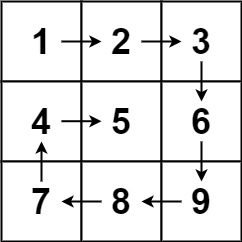15 Jan 54. Spiral Matrix
Given an m x n matrix, return all elements of the matrix in spiral order.
Example 1:

Input: matrix = [[1,2,3],[4,5,6],[7,8,9]] Output: [1,2,3,6,9,8,7,4,5]
Example 2:

Input: matrix = [[1,2,3,4],[5,6,7,8],[9,10,11,12]] Output: [1,2,3,4,8,12,11,10,9,5,6,7]
Constraints:
m == matrix.lengthn == matrix[i].length1 <= m, n <= 10-100 <= matrix[i][j] <= 100
题目大意
顺时针螺旋着打印二维矩阵。
解题方法
维护四个边界和运动方向
螺旋打印,一定会在遍历的时候更改方向。在什么时候更改方向呢?在最外圈运动的时候是到达边界的时候。但是当移动到Example 1中4的位置时,要向右移动(而不是向上),那么相当于上边界已经移动了第二行。
同理,我们推断:
我们维护四个边界left, right, up, down,表示尚未走过的、可以移动的矩阵范围,起始时四个边界即矩阵的边界。当每次遇到新的边界的时候,需要把移动方向顺时针旋转90度,同时把刚刚走过的那个边界线(这条边界线上所有元素已经遍历过)需要向矩阵内移动,即缩小了边界。当所有的位置都被遍历了一次,则停止。
python代码如下,核心是每次遇到新的边界时,顺时针修改移动方向,并且将老边界内移。
class Solution(object):
def spiralOrder(self, matrix):
“””
:type matrix: List[List[int]]
:rtype: List[int]
“””
if not matrix or not matrix[0]: return []
M, N = len(matrix), len(matrix[0])
left, right, up, down = 0, N – 1, 0, M – 1
res = []
x, y = 0, 0
dirs = [(0, 1), (1, 0), (0, -1), (-1, 0)]
cur_d = 0
while len(res) != M * N:
res.append(matrix[x][y])
if cur_d == 0 and y == right:
cur_d += 1
up += 1
elif cur_d == 1 and x == down:
cur_d += 1
right -= 1
elif cur_d == 2 and y == left:
cur_d += 1
down -= 1
elif cur_d == 3 and x == up:
cur_d += 1
left += 1
cur_d %= 4
x += dirs[cur_d][0]
y += dirs[cur_d][1]
return res
1
2
3
4
5
6
7
8
9
10
11
12
13
14
15
16
17
18
19
20
21
22
23
24
25
26
27
28
29
30
31
保存已经走过的位置
一个比较蠢的实现方式:使用一个二维数组保存哪些走过了。这样遍历的时候,如果发现走过了就停止。因为while断开了,所以在当前的循环方向上要回退一格,然后移动行、列。
真的比较蠢 23333
class Solution(object):
def spiralOrder(self, matrix):
“””
:type matrix: List[List[int]]
:rtype: List[int]
“””
if not matrix or not matrix[0]: return []
m, n = len(matrix), len(matrix[0])
visited = [[0] * n for _ in range(m)]
res = []
self.row, self.col = 0, 0
def spiral():
move = False
while self.col < n and not visited[self.row][self.col]:
res.append(matrix[self.row][self.col])
visited[self.row][self.col] = 1
self.col += 1
move = True
self.col -= 1
self.row += 1
while self.row < m and not visited[self.row][self.col]:
res.append(matrix[self.row][self.col])
visited[self.row][self.col] = 1
self.row += 1
move = True
self.row -= 1
self.col -= 1
while self.col >= 0 and not visited[self.row][self.col]:
res.append(matrix[self.row][self.col])
visited[self.row][self.col] = 1
self.col -= 1
move = True
self.col += 1
self.row -= 1
while self.row >= 0 and not visited[self.row][self.col]:
res.append(matrix[self.row][self.col])
visited[self.row][self.col] = 1
self.row -= 1
move = True
self.row += 1
self.col += 1
if move:
spiral()
spiral()
return res
原文链接:https://blog.csdn.net/fuxuemingzhu/article/details/79541501


No Comments